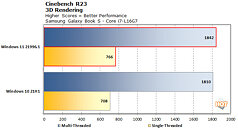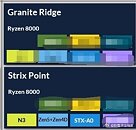
AMD "Strix Point" Mobile Processor Confirmed 12-core/24-thread, But Misses Out on PCIe Gen 5
AMD's next-generation Ryzen 9000 "Strix Point" mobile processor, which succeeds the current Ryzen 8040 "Hawk Point" and Ryzen 7040 "Phoenix," is confirmed to feature a CPU core-configuration of 12-core/24-thread, according to a specs-leak by HKEPC citing sources among notebook OEMs. It appears like Computex 2024 will be big for AMD, with the company preparing next-gen processor announcements across the desktop and notebook lines. Both the "Strix Point" mobile processor and "Granite Ridge" desktop processor debut the company's next "Zen 5" microarchitecture.
Perhaps the biggest takeaway from "Zen 5" is that AMD has increased the number of CPU cores per CCX from 8 in "Zen 3" and "Zen 4," to 12 in "Zen 5." While this doesn't affect the core-counts of its CCD chiplets (which are still expected to be 8-core), the "Strix Point" processor appears to use one giant CCX with 12 cores. Each of the "Zen 5" cores has a 1 MB dedicated L2 cache, while the 12 cores share a 24 MB L3 cache. The 12-core/24-thread CPU, besides the generational IPC gains introduced by "Zen 5," marks a 50% increase in CPU muscle over "Hawk Point." It's not just the CPU complex, even the iGPU sees a hardware update.
Perhaps the biggest takeaway from "Zen 5" is that AMD has increased the number of CPU cores per CCX from 8 in "Zen 3" and "Zen 4," to 12 in "Zen 5." While this doesn't affect the core-counts of its CCD chiplets (which are still expected to be 8-core), the "Strix Point" processor appears to use one giant CCX with 12 cores. Each of the "Zen 5" cores has a 1 MB dedicated L2 cache, while the 12 cores share a 24 MB L3 cache. The 12-core/24-thread CPU, besides the generational IPC gains introduced by "Zen 5," marks a 50% increase in CPU muscle over "Hawk Point." It's not just the CPU complex, even the iGPU sees a hardware update.


















































